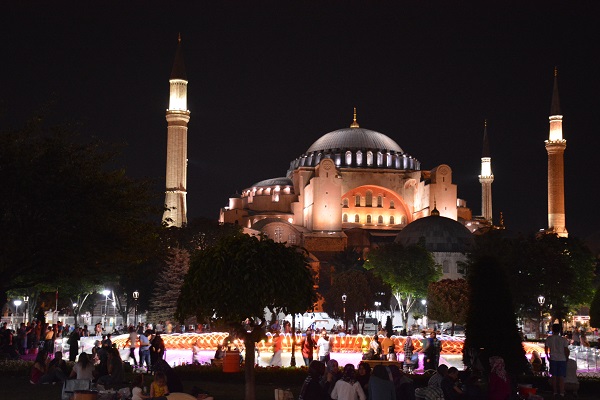June 17-20, 2016 —
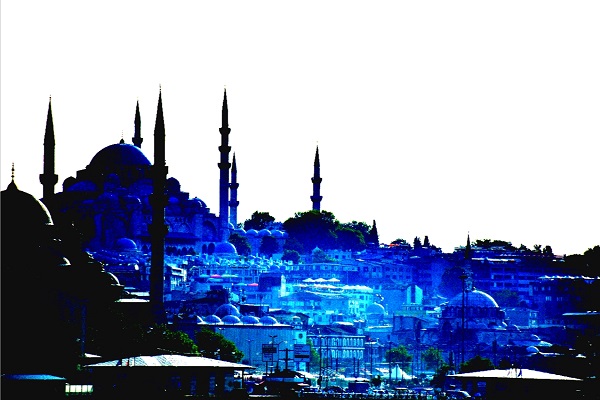 We flew to Istanbul from Bodrum, a quick flight. Istanbul is the fifth largest city in the world by population and the largest city to span two continents; Europe and Asia. The city is separated by the Bosphorus Strait a 20-mile-long waterway that connects the Black Sea with the Mediterranean Sea. Istanbul is an amazing city; beautiful by any standard, architecturally stunning and historically significant. Today´s Istanbul is a city that dates back to 660 BC. Over the course of history it has had two other names; Byzantium and Constantinople, and been the seat of two empires; Roman (Byzantine) and Ottoman. Istanbul has also been instrumental in the development of two religions; Christianity and Islam.
We flew to Istanbul from Bodrum, a quick flight. Istanbul is the fifth largest city in the world by population and the largest city to span two continents; Europe and Asia. The city is separated by the Bosphorus Strait a 20-mile-long waterway that connects the Black Sea with the Mediterranean Sea. Istanbul is an amazing city; beautiful by any standard, architecturally stunning and historically significant. Today´s Istanbul is a city that dates back to 660 BC. Over the course of history it has had two other names; Byzantium and Constantinople, and been the seat of two empires; Roman (Byzantine) and Ottoman. Istanbul has also been instrumental in the development of two religions; Christianity and Islam.
Debby, Sara´s friend from childhood, had spent time in Istanbul several years earlier and is an experienced world traveler. Having done all of her research and even laid out the schedule for seeing everything efficiently in just a three days, we put her in charge. 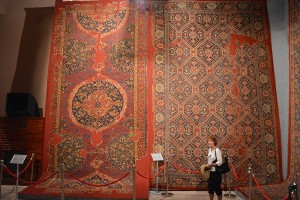 We needed sneakers to keep up! After dropping our luggage at Ferman Hotel, nice and well located in the Sultanahmet (historic) area of Istanbul, our first stop was the Carpet Museum. The Carpet Museum was started and funded by one person and has a collection of very old, mostly 1700/1800 Persian rugs largely from mosques across Turkey. Some of the old carpets were beautiful and massive in size!
We needed sneakers to keep up! After dropping our luggage at Ferman Hotel, nice and well located in the Sultanahmet (historic) area of Istanbul, our first stop was the Carpet Museum. The Carpet Museum was started and funded by one person and has a collection of very old, mostly 1700/1800 Persian rugs largely from mosques across Turkey. Some of the old carpets were beautiful and massive in size!
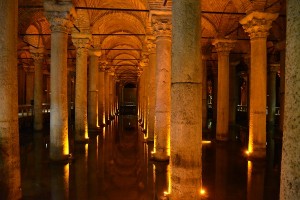 The Basilica Cistern, the largest surviving Byzantine cistern in Istanbul, built in 532, was our next stop. It delivered water to the Great Palace and surrounding buildings from a reservoir near the Black Sea via 20 km of aqueducts. It is constructed with 336 columns set symmetrically. Many of them were brought from ruined temples so they were all different. Dan Brown included a scene played out in the Cistern in his novel “Inferno”, which is due out as a movie later this year. Last June the Cistern was closed for four days for the filming of that scene.
The Basilica Cistern, the largest surviving Byzantine cistern in Istanbul, built in 532, was our next stop. It delivered water to the Great Palace and surrounding buildings from a reservoir near the Black Sea via 20 km of aqueducts. It is constructed with 336 columns set symmetrically. Many of them were brought from ruined temples so they were all different. Dan Brown included a scene played out in the Cistern in his novel “Inferno”, which is due out as a movie later this year. Last June the Cistern was closed for four days for the filming of that scene.
One million people cross the Bosphorus daily to get to work, moving them between Europe and Asia. The waterway is bustling with ferries most of the day along with cargo ships traveling to and from the Black Sea. It was amazing to watch the volume of marine traffic! 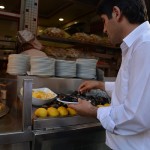 We ended our first day with a ferry ride across the Bosporus to Kadikoy, on the Asian side of Istanbul, where we enjoyed a cold beer and the local mussels stuffed with rice, a seasonal favorite.
We ended our first day with a ferry ride across the Bosporus to Kadikoy, on the Asian side of Istanbul, where we enjoyed a cold beer and the local mussels stuffed with rice, a seasonal favorite.
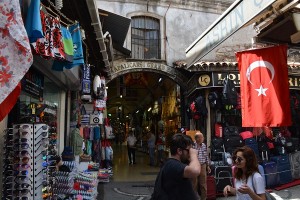 Over the next three days we spent time at the famous Grand Bazaar known for the opportunity to haggle over prices with local vendors. We were shocked at how empty it was. A combination of low tourism and this being the month of Ramadan, most of the stores were empty. The spice bazaar, a few blocks away was similarly short of shoppers. Other highlights included the Topkapi Palace, the court of the Ottoman Empire from the 15th to 19th centuries.
Over the next three days we spent time at the famous Grand Bazaar known for the opportunity to haggle over prices with local vendors. We were shocked at how empty it was. A combination of low tourism and this being the month of Ramadan, most of the stores were empty. The spice bazaar, a few blocks away was similarly short of shoppers. Other highlights included the Topkapi Palace, the court of the Ottoman Empire from the 15th to 19th centuries. 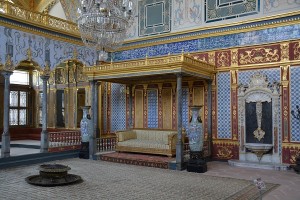 Also housed there is the Harem, where the Sultan and his family including wives, children, and concubines lived. Life in the Harem was governed by tradition and rules, with the Sultan’s mother having a dominant role in selecting the Sultan’s wives and special concubines as well as influencing decisions of the Sultan on matters of state. The detail in the hand painted walls and ceilings and amount of gold is amazing. The nearby Archeological Museum and Tile Museum were worthwhile, and the vast Suleymaniye Mosque (for Suleyman the Magnificent) is among the greatest Ottoman architecture.
Also housed there is the Harem, where the Sultan and his family including wives, children, and concubines lived. Life in the Harem was governed by tradition and rules, with the Sultan’s mother having a dominant role in selecting the Sultan’s wives and special concubines as well as influencing decisions of the Sultan on matters of state. The detail in the hand painted walls and ceilings and amount of gold is amazing. The nearby Archeological Museum and Tile Museum were worthwhile, and the vast Suleymaniye Mosque (for Suleyman the Magnificent) is among the greatest Ottoman architecture.
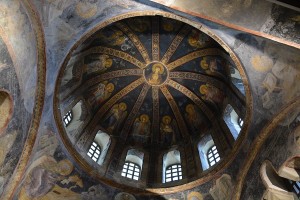 A bit off the main path and one of our favorite spots was the Chora Museum Church, built in the 1300s. It was a Christian church which is unique in that it was not converted to a mosque, and is filled with mosaics and frescoes on the walls and ceilings. Inside one of the two domes is a mosaic depicting Jesus and his ancestors (“The Genealogy of Christ”). Another dome has the mosaic “Mary and the Baby Jesus Surrounded by Ancestors”.
A bit off the main path and one of our favorite spots was the Chora Museum Church, built in the 1300s. It was a Christian church which is unique in that it was not converted to a mosque, and is filled with mosaics and frescoes on the walls and ceilings. Inside one of the two domes is a mosaic depicting Jesus and his ancestors (“The Genealogy of Christ”). Another dome has the mosaic “Mary and the Baby Jesus Surrounded by Ancestors”.
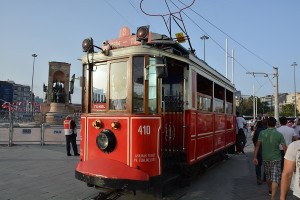 On our last evening we went to Taksim Square, the heart of modern Istanbul, which is located on the Europe side of the Bosphorus. It is a gathering place for young people, filled with restaurants, bars and shopping. It has also been more recently known for demonstrations held there. We arrived to see 300 Turkish police officers with riot gear and anti-riot water cannon trucks. Just a few hours before we got there a group of about 50 LGBT demonstrators had been dispersed by the police using water cannons and rubber bullets.
On our last evening we went to Taksim Square, the heart of modern Istanbul, which is located on the Europe side of the Bosphorus. It is a gathering place for young people, filled with restaurants, bars and shopping. It has also been more recently known for demonstrations held there. We arrived to see 300 Turkish police officers with riot gear and anti-riot water cannon trucks. Just a few hours before we got there a group of about 50 LGBT demonstrators had been dispersed by the police using water cannons and rubber bullets. 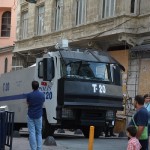 The demonstrators were gone, but the police remained to keep the group from reconvening. Groups of about 10 police with their riot gear were stationed at each cross street of the main avenue running through the neighborhood. Turkey is a secular state but Erdogan, who is currently in power, is very conservative and unfortunately appears to be changing things.
The demonstrators were gone, but the police remained to keep the group from reconvening. Groups of about 10 police with their riot gear were stationed at each cross street of the main avenue running through the neighborhood. Turkey is a secular state but Erdogan, who is currently in power, is very conservative and unfortunately appears to be changing things.
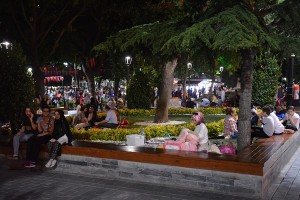 This month is the Muslim season of Ramadan. About 45% of Muslims in Turkey observe Ramadan, eating and drinking nothing all day. Each evening, as the fast is broken, families gathered all around the city having picnics and enjoying restaurants.
This month is the Muslim season of Ramadan. About 45% of Muslims in Turkey observe Ramadan, eating and drinking nothing all day. Each evening, as the fast is broken, families gathered all around the city having picnics and enjoying restaurants.
Istanbul is a very cosmopolitan city. While mindful of our surroundings, we felt very safe there.

